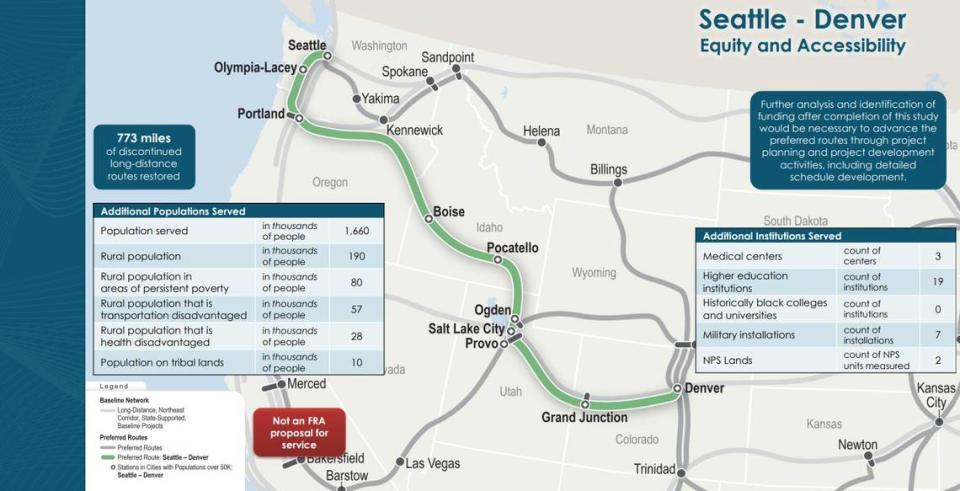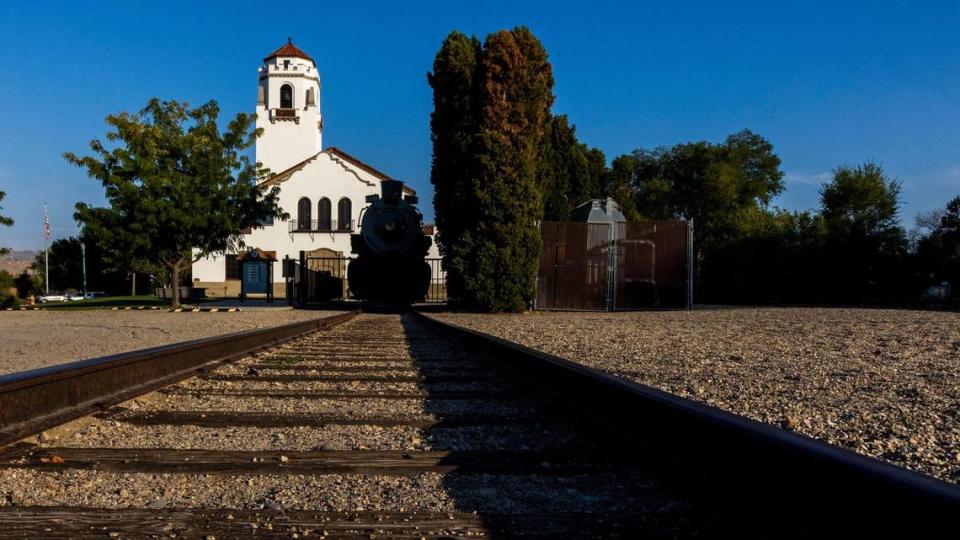Another shot at a Boise-Salt Lake City Amtrak rail line? Feds include route in review
A new passenger rail line in Boise may have another route forward after hopes for the service were stymied last year from a blown opportunity for federal funding.
The Federal Railroad Administration continued work this month toward mapping an expanded network of routes across the U.S., including the defunct Pioneer Line that made several stops in Idaho before it was terminated in 1997. Congress approved a study phase that includes the western leg of the discontinued Amtrak line — from Seattle to Denver with stops in Boise, Pocatello and Salt Lake City.
The federal review is separate from the joint effort between Boise and Salt Lake City on a proposal for a shorter Amtrak line that would connect the two Western capitals. That project has generated local enthusiasm but so far been unable to gain traction toward development.
The Railroad Administration’s report on the 15 proposed long-distance Amtrak routes, defined as greater than 750 miles in length, is set to be finished and submitted to Congress later this year, William Wong, spokesperson for the federal agency, said in an email to the Idaho Statesman. He sought to temper expectations over the study’s results, however, given any lines eventually approved would be years away and require significant public investment.
“The proposed routes and schedules in the study are conceptual,” Wong said. “The study is meant to set forth a set of potential options for what could occur in the future, not necessarily what will happen.”
The Railroad Administration estimated next year’s price tag for restoring the long-distance route that includes Boise and Pocatello at $2.1 billion to $5.4 billion, plus between $75 million and $106 million in annual operations costs. That compares to an Amtrak study in 2009 that estimated the same one-time capital costs of a Seattle to Denver line with stops in Idaho at $493 million, plus $46.2 million in annual operations costs.
In addition, the report rated the Seattle to Denver line a 7 on a 15-point scale for priority, based on factors that could lead to actual adoption. The grade makes the line tied for second-to-last among the 15 long-distance routes in the federal study.

Nonetheless, the prospect remains intriguing to the Treasure Valley and beyond, even if city leaders continue to push for the direct line with Utah’s major metropolitan area known as the Wasatch Front. Boise Mayor Lauren McLean remains one of the idea’s flag-bearers.
“We are excited to see service between Boise and Salt Lake could exist in a future long-distance network, but this is fundamentally different than state-supported service between two city pairs,” Bre Brush, McLean’s transportation adviser, said in an email to the Statesman. “We continue to believe that service between the Treasure Valley and the Wasatch Front would be transformational for our communities and are actively seeking ways to keep the momentum we built last year going.”
Boise rail line application setback
City officials have for years been working on plans to bring back Amtrak to the region after federal budget cuts left Boise and neighboring cities without service nearly three decades ago. Gov. Brad Little and most of Idaho’s federal lawmakers have been outspoken in their support of restoring more widespread passenger rail service in the state.
“Now it is clear the public wants more Amtrak service,” Amtrak said in a statement provided to the Statesman. “In this process, the public has spoken directly and through their elected and appointed local, tribal, state and federal leaders.”
The $1.2 trillion federal infrastructure law, passed in November 2021 with bipartisan support, included tens of billions to upgrade and expand the nation’s passenger rail system. Of that, $15 million was set aside for the study of long-distance routes, offering Boise and surrounding communities a path back into the national passenger rail system.
Half-million-dollar grants also are available for study of proposed rail lines shorter than 750 miles. The deadline for the first round of applications was last year, with the U.S. Department of Transportation awarding $34.5 million to 69 projects throughout the U.S.

The cities of Boise and Salt Lake City, with their state transportation agencies, collaborated on their proposal for the 340-mile rail line. Then they applied — or at least thought they did.
The grant awards were announced in December, but the Boise-Salt Lake City line was left out among them. Idaho Transportation Department officials later acknowledged they had actually failed to submit for the proper grant, which made the project ineligible for possible funding.
“This was an error, and we feel bad. But mistakes happen, we’re human,” ITD spokesperson John Tomlinson previously told the Statesman.
Boise’s plans were derailed before they could ever leave the station. Brush vented the city’s frustration at the time over the self-inflicted wound that disqualified the application from consideration for a planning grant.
“Of course it’s disappointing,” she previously told the Statesman.
The Federal Railroad Administration plans to open up the short-distance route grant application for a second round of funding next year, Wong told the Statesman. The city intends to submit for the proper grant next time around, Brush said.
In the meantime, the federal long-distance route study may prove the option that eventually brings passenger rail service back to Boise.
“This study has shown our Amtrak trains need to go to more places — and more often,” Amtrak’s statement said. “We stand ready to help a coalition who wants this study to be the foundation of an increase in passenger rail service.”


